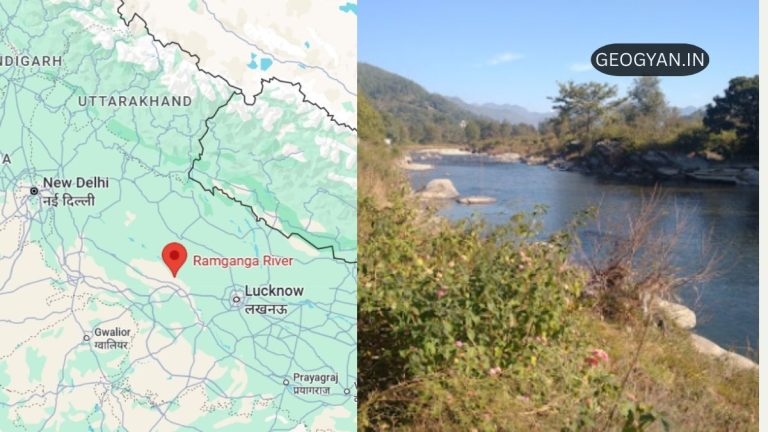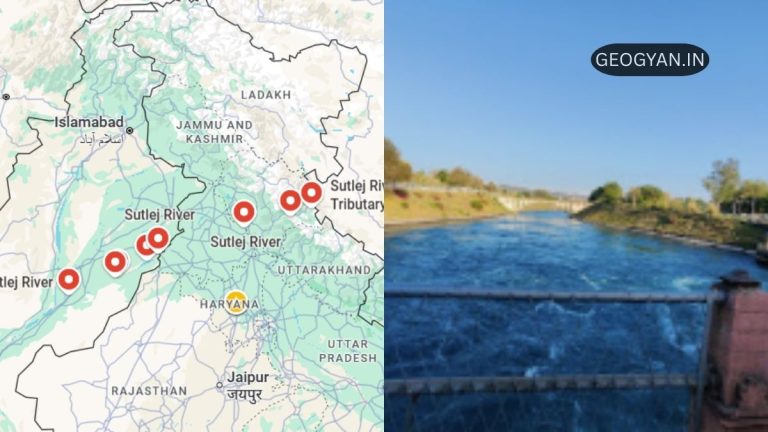Estimated reading time: 3 minutes

Table of contents
- Why is Dhasan River in News Recently?
- Origin place of the Dhasan River?
- Course and Length of the Dhasan River?
- What are the Major Uses of the Dhasan River?
- Geographical Features of the Dhasan River Basin?
- Historical and Cultural Importance of the Dhasan River?
- Quick Exam Facts on Dhasan River
- FAQs
- Also Read
Why is Dhasan River in News Recently?
Dhasan River is recently in the news due to the overflow of the Lahchura Dam, where five gates were opened and 26,000 cusecs of water were discharged into the river, causing a flood alert in surrounding areas.
This precaution was taken after heavy rainfall increased the dam’s water level to maximum capacity, impacting nearby villages across Uttar Pradesh and Madhya Pradesh with warnings issued to residents to stay away from the riverbanks.
Origin place of the Dhasan River?
The Dhasan River originates from the Begumganj tehsil of Raisen district in Madhya Pradesh. It flows through the rugged Bundelkhand plateau before joining the Betwa River near Orchha.
Dhasan is one of the important tributaries of the Betwa River, which itself is a part of the Yamuna river system. The river’s name is believed to have been derived from the Sanskrit word “Dasharna”, a historical region mentioned in ancient texts.
Course and Length of the Dhasan River?
- The river flows for about 365 km, out of which 266 km lies in Madhya Pradesh and the rest in Uttar Pradesh.
- Its course passes through granite rocks, plateaus, and fertile plains, which makes it significant both geographically and economically.
- The Dhasan River touches Sagar, Tikamgarh, and Lalitpur districts, before meeting Betwa near Orchha.
- It forms natural boundaries between Madhya Pradesh and Uttar Pradesh in several stretches.
What are the Major Uses of the Dhasan River?
- The river provides irrigation to thousands of hectares in Bundelkhand.
- Dams and barrages like the Ranguan Dam have been built on it.
- The river supports drinking water supply and fisheries in some parts.
- Due to irregular monsoons, Bundelkhand’s irrigation is heavily dependent on rivers like the Dhasan, Betwa, and Ken.
- Small check dams and canals from Dhasan have created minor irrigation networks that sustain crops like wheat, pulses, and oilseeds.
Geographical Features of the Dhasan River Basin?
- Region: Bundelkhand Plateau
- Type of Rocks: Granite and Vindhyan sandstone
- Climate: Semi-arid with frequent droughts
- Soil: Black and alluvial soils dominate the basin area
Historical and Cultural Importance of the Dhasan River?
In history, the Dhasan River served as a boundary between Malwa and Bundelkhand. It is mentioned in several ancient texts and folklore. Local communities still regard it as a sacred river, performing rituals on its banks.
Ancient Chandela and Bundela rulers also used the river as a natural defense line in wars.
Quick Exam Facts on Dhasan River
- Origin: Begumganj, Raisen district, Madhya Pradesh
- Length: 365 km
- States Covered: Madhya Pradesh, Uttar Pradesh
- Major Tributary of: Betwa River
- Important Dam: Ranguan Dam
- Region: Bundelkhand Plateau
FAQs
Q1. Where does the Dhasan River originate?
It originates from Begumganj tehsil in Raisen district, Madhya Pradesh. The source region lies in the Vindhyan range foothills.
Q2. Which river does the Dhasan join?
It joins the Betwa River near Orchha. Betwa further merges with the Yamuna, making Dhasan a part of the Ganga basin.
Q3. Why is the Dhasan River important for Bundelkhand?
It provides irrigation, water supply, and supports agriculture in a drought-prone region. Farmers also depend on traditional water harvesting structures linked with Dhasan.
Q4. What is the length of the Dhasan River?
It flows for about 365 km, of which 266 km in Madhya Pradesh. Its remaining course in Uttar Pradesh contributes to Lalitpur’s agriculture.





























